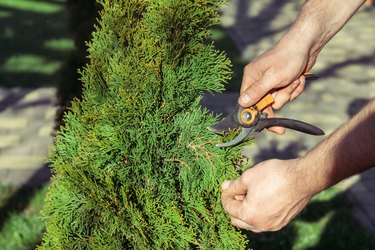
When your emerald green arborvitaes (Thuja occidentalis) are turning yellow, they might just be shedding leaves to make way for new ones, or they could be in trouble. Water — either too much or too little — can cause yellowing leaves, or your plant may be lacking in nutrients.
Late Summer or Fall Needle Drop
Video of the Day
Just as deciduous trees shed their leaves in fall, also drop yellowing leaves at the end of the growing season. This is particularly true of arborvitaes and most pine trees. The yellowing occurs uniformly from the top of the tree to the bottom, although the tips of the branches will stay green. If your branch tips are green and it's the end of the growing season, this is a natural occurrence and nothing to worry about.
Video of the Day
Too Much or Too Little Water
The most common reason for yellowing leaves on many trees and bushes, including the arborvitae, is either lack of water or too much water. Arborvitaes need regular, moderate watering and require well-draining soils. During the warm summer months, ensure that you have a regular watering schedule in place. Before watering, however, poke your finger into the soil to test its moisture level. If the soil is wet, wait several days and then try again.
If the soil remains wet, then that area of your yard is likely retaining too much moisture and draining poorly. If this is the case, your arborvitae will never thrive in that location, and you should dig it up and transplant it. To ensure the best environment for your arborvitae, find a place that you know drains well. Add compost or other organic matter into the planting hole to improve soil texture and drainage.
Yellowing Leaves Due to Pests or Disease
The arborvitae is susceptible to a number of pests, and damage typically shows as yellowing leaves. The cypress tipminer feeds on arborvitae, coast redwood, juniper, and cypress. The larvae will chew the inside foliage, causing it to first turn yellow in early winter and then brown by late winter before it dies.
Another damaging pest is minute cypress scale, which can weaken a plant. Leaves turn yellow, and the arborvitae may appear drought-stressed. The affected leaves may remain on the plant after turning brown, giving it a scorched appearance. In addition, the larvae of leaf miner injure the growth tips, turning them yellow and eventually brown.
Phytophthora root rot causes leaves and roots to turn yellow. Eventually, this disease will kill the plant. The roots will be discolored below the bark and eventually will be decomposed and crumble if you dig up the plant. Root rot is most likely when an arborvitae is planted in poorly draining soil.
Yellowing Leaves Due to Nutrient Deficiency
Yellowing leaves can be due to a deficiency in nutrients and may result in chlorosis, which is an inability to produce enough chlorophyll. A lack of nitrogen is one culprit, resulting in a yellowing that first appears on the older, inner leaves and then progresses to the younger leaves on the outside. Too little potassium can turn the leaf's edges yellow while the inner leaf remains green. A deficiency in iron is among the most common reasons for chlorosis and appears between the leaf veins so that the leaf is yellow while the veins are still green.
The best way to identify a nutrient deficiency is to test the soil. First, test for pH to ensure that the soil has the right pH for arborvitaes (6.0 to 8.0). Then, test for nutrients in the soil. Purchase a commercially available soil test kit or contact your local university extension office for advice.